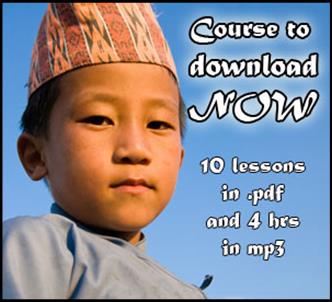|
BUDDHISM - Religion of Nepal
Buddhism, the fourth largest religion (in terms of followers) in the world was founded by Gautama Buddha ( Pre-monastic name – Siddhartha). Referred to as the Most Enlightened One, Buddha is believed by followers from all over the world to have attained Nirvana, or enlightenment. Buddhism has massive following in South-East and Eastern Asia and has gained popularity all over the world. Considered to be a peacefull philosophy buddhism is getting very popular in the western world. Buddhism is also a very important religion of Nepal and many travelers will have the pleasure to get in touch with this marvellous philosophy of Asia.
BUDDHISM : FOUNDATION:
Born a prince of the small tribal kingdom of Kapilavastu, in Lumbini, Siddhartha lived a luxurious life. But at the age of 29, greatly disturbed by scenes of suffering of common men, and the endless cycle of life and death, he left home in search of a solution. He went on deep meditation ( Dhyaan and Dhaarana) under a Bodhi tree in modern Varanasi (Bodh Gaya), he attained Nirvana or enlightenment. Buddhism was basically founded due to the complications in the then Indian Society, which was deeply centered around the Brahmins and their complex rituals.
BUDDHISM : BASIC CONCEPTION:
While on his path to enlightenment, Buddha searched for a way out of the endless suffering. And after foundation of Buddhism, he laid out the four noble truths, derived by simple logic.
In life, there is suffering. The root cause of suffering is Desire. If there is no desire, then there will be no suffering. The way to cure this is to follow the eight-fold path in Buddhism.
Buddhism has since then followed these basic ideals laid down by Buddha. The Eight Fold path, or as it is described in Buddhism – the Path To Liberation, is basically divided into three chains, namely, Prajna, Sila and Samadhi. The First Principle relates to the intelligence of man and perception of the true nature of the universe and rejection of materialism. The second principle is the purification of mind, its separation from the body, and the separation of the self and the body by imparting noble qualities within oneself. The third and final step, is the renunciation of the body and mind, and getting free from the circle of life and death (Jeevan Chakra). According to Buddhism, these three steps are essential to attain Moksha or Nirvana or Enlightenment. A person that has been enlightened, is then called a Bodhisattva; also one of the names of Gautama.
BUDDHISM AND ITS INFLUENCE IN MIDDLE AGE:
Buddhism was spreading far and wide in South East Asia, East Asia and the Indian subcontinent. Rulers like Ashoka, who had personally taken up Buddhism, helped spread Buddhism as far as Ceylon (Presently Sri Lanka) , Malaysia and Singapore. A considerable portion of Buddhist history was revived by the Indian ruler – Kanishka.
BUDDHISM AFTER BUDDHA:
As history speaks, Buddhism changed vigorously after the Parinirvana of Buddha. Before his death, Buddha instructed specifically to all his followers not to have any leader. Within a year, Buddhism was divided into two groups, which subsequently led to further subdivisions during the course of time. Presently, there are two major branches of Buddhism – Theravada (the Oldest Buddhist sect in existence today) and the Mahayana. |


|
Learn Nepali now |
|
> Quick and safe payment (https) > Useful vocabulary > 4 hours of audio material in .mp3 > Focus on travel > Perfect for independent traveler
> More than 4250 downloads since 2012
29 € today Normally 55 €
|
|
Quick & Safe payment
Download link sent to your email
The best way to enjoy Nepal
info@himalaya-nepal.com |